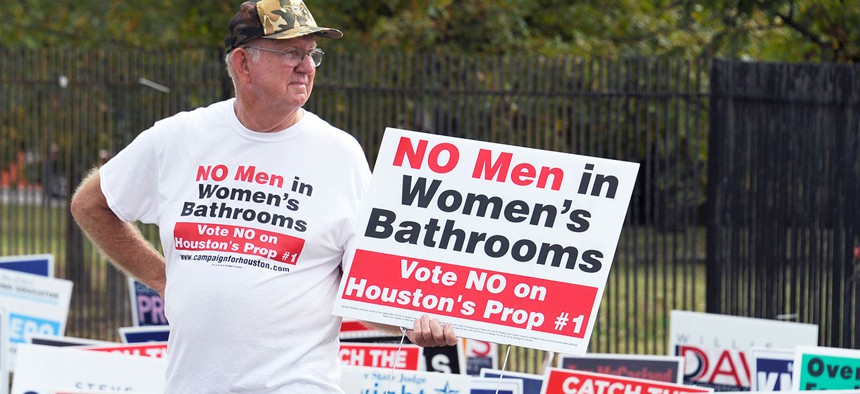Why a Court Blocked the Obama Administration’s Guidelines on Trans Students

A demonstrator holds a sign against the Houston Equal Rights Ordinance outside an early voting center in Houston in 2015. Pat Sullivan/AP file photo
A federal judge in Texas has ruled that the Department of Education didn’t follow proper rule-making procedures in sending a letter about bathrooms to schools.
This spring, when the Obama administration issued a letter to schools across the country about how they should treat transgender students, LGBT advocates celebrated. They believed the U.S. Department of Education’s guidelines would force schools in every state to let transgender kids use the bathroom that corresponds to their gender identity and put other accommodations in place.
But on Sunday, a federal district-court judge in Texas put an abrupt halt to the enforcement of those guidelines nationwide, arguing that the administration has possibly misinterpreted federal law and failed to follow proper rule-making procedures.
The ruling is part of an on-going battle between the courts and the executive branch over the meaning of “sex discrimination,” which is outlawed nationally in schools and certain workplaces. Over the last several years, the Obama administration has shifted its interpretation of the term, arguing that it includes discrimination against people on the basis of their gender identity—how they act out their male or femaleness, or, in the case of transgender people, if they change genders. This interpretation has been successfully used in just a couple of court cases about discrimination at a school or business, including a recent case concerning a transgender boy in Virginia.
But the administration’s interpretation is also widely contested. Last May, 13 states and agencies joined together to sue the Department of Education over the letter, along with the Departments of Labor and Justice and the Equal Employment Opportunity Commission. Courts have also been widely skeptical of this interpretation, even though some judges have acknowledged that a conflicting body of court precedents may have added to the confusion. This conflict over interpretations stems from the fact that the federal government does not explicitly prohibit discrimination against LGBT people in housing, hiring, or public accommodations, including schools, and only about half of states have these kinds of protections on the books.
In their suit against the Department of Education, the states argued that the administration’s inclusion of “gender identity” in its interpretation of “sex discrimination” goes against the original intent of Title IX of the Education Amendments of 1972. As the court’s decision pointed out, “during that time period, virtually every dictionary definition of ‘sex’ referred to the physiological distinctions between males and females, particularly with respect to their reproductive functions.”
At the time when Title IX was passed by Congress, legislators were mostly concerned about discrimination against girls in schools, whether on sports teams or in the classroom. Since legislative intent is an important factor in how most judges interpret statutes, the states in this case argued, the Obama administration shouldn’t be able to interpret Title IX to include discrimination against transgender students. The Texas district-court judge agreed.
The other significant component of the states’ argument was that the Obama administration failed to follow the guidelines for federal rule-making that are set out in the Administrative Procedures Act, a law that’s been in place for 70 years. According to the Act, whenever the executive branch decides to issue guidance on how it’s interpreting a law written by Congress, it has to go through a notice-and-comment process—the public has to have a chance to weigh in on how the government is choosing to enforce the law. In this case, the administration skipped that process, arguing that it wasn’t obliged to go through a full comment period. The Texas court disagreed, writing that the administration failed to follow the correct steps for public review.
While this last aspect of the decision may seem like a dry procedural back-and-forth, it speaks to the tension at the core of this court dispute: At least for the purposes of the law, the American people have not had much chance to speak out on what “sex discrimination” should mean, or who they want to be protected under the law. Even though Congress has had several chances to consider new legislation that would explicitly protect LGBT people from discrimination on the basis of sexual orientation or gender identity, the legislature has so far declined to pass any law of this kind, and seems unlikely to do so any time soon. By skipping the notice-and-comment process with its guidance letter on transgender students, the Obama administration eliminated yet another chance for the public to weigh in on this issue.
While the administration claimed in this case that its letter does not carry the force of law, and thus doesn’t require any court action on enforcement, the plaintiffs successfully argued that the administration is effectively coercing states by threatening to take away federal education money.
The Obama administration wants to take immediate action on what it sees as protecting transgender children. But this injunction is an illustration of how unilateral policymaking can backfire. It also suggests the administration may have a tough time convincing the courts that it, rather than Congress, has the power to determine how the federal government treats transgender kids.
NEXT STORY: Does Diversifying Police Forces Reduce Tensions?





